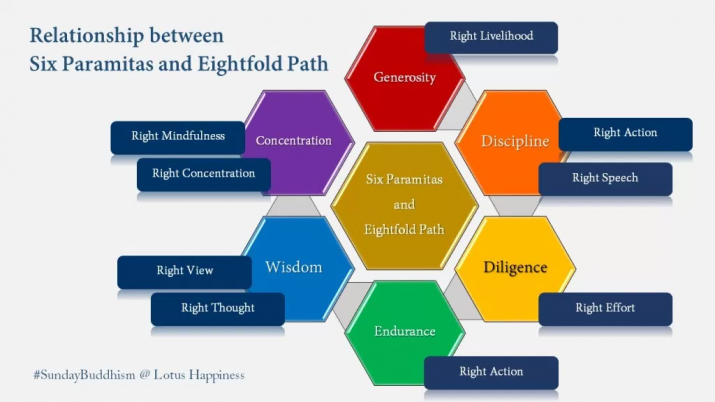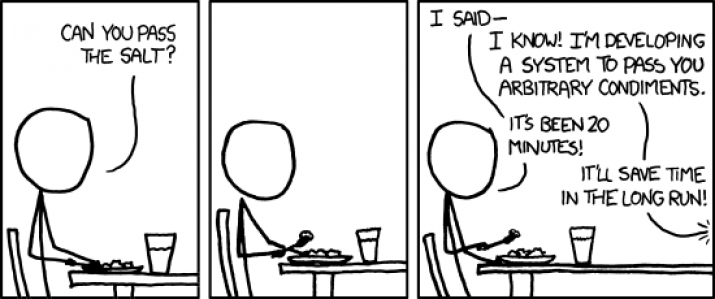FEATURES|COLUMNS|Mindful Technology
Right Effort in Systems Design
 From davidmieloch.com
From davidmieloch.comAt long last I see
a brahman, totally unbound,
who
without pushing forward,
without staying in place,
has crossed over
the entanglements
of the world. — SN 1:1
The eightfold noble path expounded in the fourth section of the Lotus Sutra, devoted to “ending suffering,” should be considered as an “integrated set,” not as a discrete steps. The eight steps of the path are not intended to be sequential, but to be adhered to in synergy, they support strengthen and justify each other. They can also be mapped to other Dharma values such as the six paramitas as depicted in the following illustration:
 Relationship between Eightfold Path and Six Paramitas. From lotus-happiness.com
Relationship between Eightfold Path and Six Paramitas. From lotus-happiness.comFollowing my previous articles on right view, right aspiration, right speech, and right action in systems design, today's column is about right effort (Pali: Samma Vayama).
Effort in the Dharma is intended as focus and intent, an intellectual and spiritual effort, rather than a material or physical one. Yet, even focus and intent do, to some extent, depend on the availability of physical and material resources, such as a healthy body, nourishment, sufficient time, and a suitable environment to practice the intellectual and spiritual right effort.
Like everything else, especially in the Dharma, there is no single way of defining guiding principles, and there is a wide spectrum of possibilities and contexts to differentiate right from wrong.
Right effort, semantically, can be interpreted in more than one sense: generally intended as “to put effort where appropriate”, but it can also refer to an ethical position, as in “right vs wrong,” or even right as in ”right amount;” neither too much nor not too little.
The more practitioners acquire an understanding about life, the universe, their role in it, about karma, interdependent origination, and how everything works, the more their awareness of natural dynamics increases. Right effort can be considered a balancing act, depending on situation, context, and purpose. To be a Buddha is the ultimate goal of all enlightened activities, it is essentially the sincere wish to bring benefits to all beings.
In terms of reaching enlightenment, it’s hard to state unambiguously what is right effort, because reaching enlightenment such a grand thing to most of us. However spiritual one might be, it can seem inconceivable, let alone attainable. And this heavily depends on individual karma. One could say that no amount of effort is “right” (quantitatively) to achieve such a seemingly inconceivable goal.
How many prostrations, recitations, and mandalas would count as right effort? How many confessions, acts of kindness, and aspirations are necessary to realize a good heart, and how many to attain actual enlightenment? How much suffering must one endure to develop enough empathy and introspection to reach full realization?
Although we are given some confidence by the Dharma, which tells us that each of us has Buddha nature, that ultimately we are all Buddhas, deep inside we may not have the confidence, mostly because we cannot even contemplate what it is like to be enlightened, to be a Buddha, let alone be able to estimate the effort required to get there.
Laziness may not be right effort in accumulation counts, but making so many prostrations that a practitioner cracks a rib, faints, or becomes too ill to continue to practice, is not right effort either.
Energy (viriya), the mental factor behind right effort, can appear in either wholesome or unwholesome forms. The same factor fuels desire, aggression, violence, and ambition on the one hand, and generosity, self-discipline, kindness, concentration, and understanding on the other. (Hinduwebsite.com)
Dharma doctrine breaks down right effort into four different broad categories, also referred to as the “right exertions:”
- • effort to prevent greed, anger and ignorance from arising.
- • effort to extinguish unwholesome qualities that already have arisen.
- • effort to cultivate skillful, or wholesome, qualities that have not yet arisen.
- • effort to strengthen the wholesome qualities that have already arisen.
From these four “right exertions”, other exertions derive: effort not to slack nor to overstrain, not to become depressed when failing to achieve desired results, to see the way things they are, effort to understand the mind, and so much more.
In common terms, these four types of right action can be translated as a gradual spectrum of refining one’s actions:
- • reduce doing those actions that are making things worse.
- • stop doing actions that are making things worse.
- • start doing actions that make things better.
- • strengthen or reinforce actions that make things better.
These four aspects of right effort are to be achieved via four types of activities, which can be described as guarding, abandoning, developing, and maintaining. These activities or strategies can also be referred to as prevention or avoidance, suppression or overcoming, preparation or developing and preservation or maintenance. Abandoning what is not helpful can be accomplished by focusing on the development of what can be constructive and helpful, such as, for instance, the practice of mindfulness.
Right effort in engineering
Systems engineering is largely based on the imitation of nature: airplanes are built imitating birds and insects that fly, marine and submarine vehicles imitate creatures that live and swim in the oceans etc. Engineered systems are becoming increasingly prevalent in our world, in addition, they are becoming more and more complex and embedded into every aspect of daily life. This makes it hard to distinguish to what point function and design still follow nature and natural dynamic and when they go against nature itself. This can result in “systemic deviation,” where a system designed to achieve a purpose, say for example a medical system designed to save lives or a legal system devised to administer justice, can become manipulated and distorted to the point of obtaining the opposite goal.
Dharma teachings, and in this case the principle of right effort, can help systems design to define and maintain the balance between desirable system outcomes and functions and those less- or non desirable, and it can help prevent the manipulation of a system.
In systemics, right effort can be addressed as efficiency: the ability to achieve the desired outcome and functionality with the minimum use of resources. Efficiency is reflected in the principle (or law) of parsimony, which states that one should choose the simplest explanation for a phenomenon, the one that requires the fewest assumptions. This applies not only to choosing a design, but also to operations and requirements.
 From blog.hasura.io
From blog.hasura.ioSystemics and technology development also rely on the concept of “optimization,” whereby the best possible function — in terms of performance and use of resources — is achieved. Optimization can be a moving target, especially in dynamic open systems where factors are constantly changing, sometimes uncontrollable, e.g. environmental factors like the weather. Socio-technical systems, where technology interacts with humans and the environment, are at their best when they are “jointly optimized,” where optimization results from ongoing adjustments between the different factors of the system and the factors respond to each other’s feedback.
Other technical concepts from the foundations of systems engineering also resonate with right effort, for example:
- • Separation of concerns, or the balance of considering parts of a problem or of a solution while not losing sight of the whole.
- • Abstraction, focusing on the essential characteristics, ignoring the non-essential, to simplify the problem from something in order to reduce it to a set of base characteristics
- • And interaction, harmonization, and balance between system properties.
There is increasing concern driving engineering practices towards “ethical systems alignment.” This article proposes that right effort, a central tenet of Dharma, could be used, experimentally perhaps, to help achieve some ethical alignment by applying a simple broad stroke logic: a system should be designed to achieve functionality and outcomes which are desirable and to avoid functionality and outcomes which are not desirable.
The four strategies or “right exertions” provided by the Dharma to help optimize the human resources geared towards enlightenment could also be useful in intelligent systems design and system development, and could be incorporated as core methods in ethical algorithm design: Prevention, suppression, preparation, and preservation.
Equally, right effort in the Dharma may benefit from an understanding of systematic dynamic alignment and joint optimization— methods in use in systems engineering—to help practitioners rationalize and systematize their practices.
Systems engineering and technology development to some extent already incorporate, perhaps unknowingly, some of the common sense methods introduced by the Buddha Dharma thousands of years ago, which have influenced, albeit unacknowledged, much of Western scientific and philosophical thinking in the modern world.
It may be mutually beneficial to further integrate the two views — Dharma and technology development — with the intent of achieving more robust systematic and replicable spiritual practices, and more ethically reliable and trustworthy engineered systems.
See more:
Right Effort on The Eightfold Path of Buddhism (Hinduwebsite.com)
The Four Right Exertions (The Wings to Awakening)
Systemic Deviation and Systems Ethics (Paola di Maio)
Maio, Paola di. 2014. “Towards a Metamodel to Support the Joint Optimization of Socio Technical Systems.” Systems. 2(3): 273-296
Buddhism - Right Effort (Hinduwebsite.com)
Principles of Systems Thinking (Sebok)















